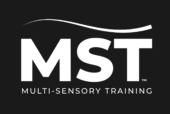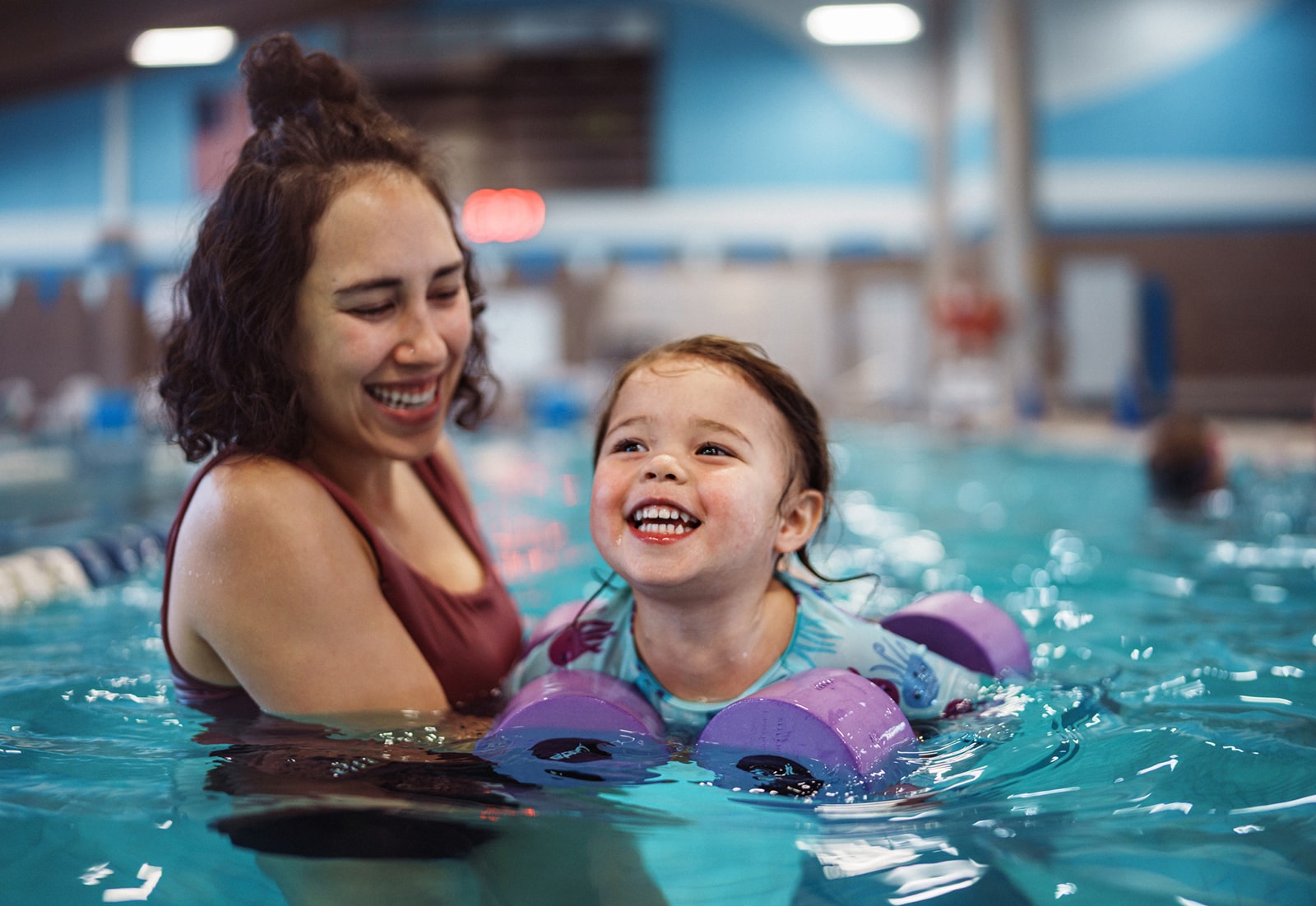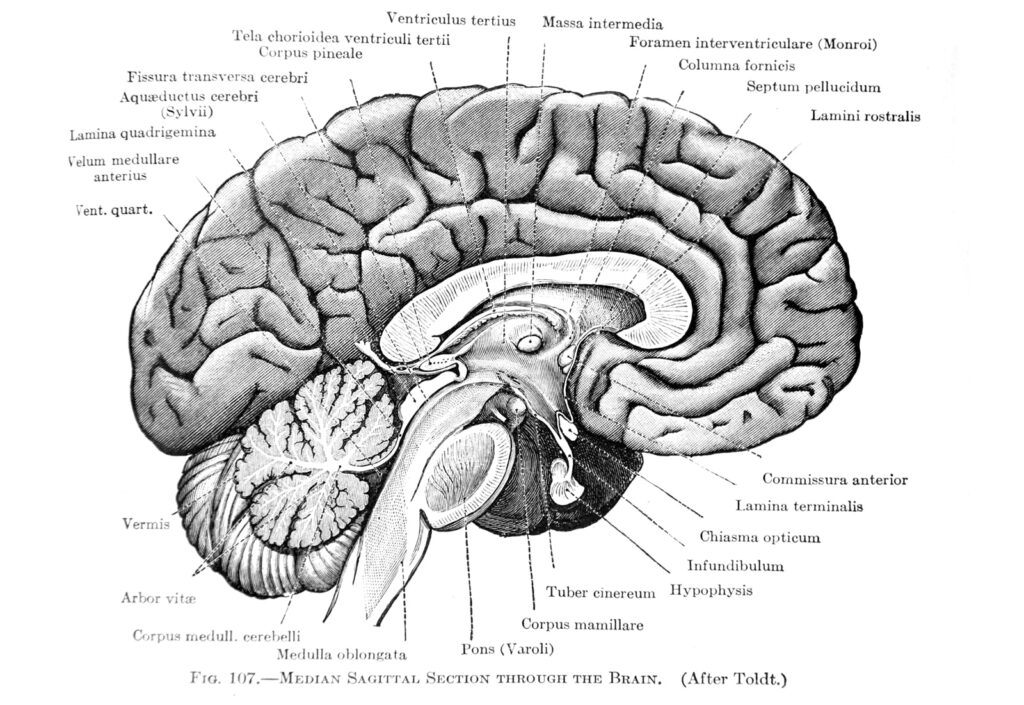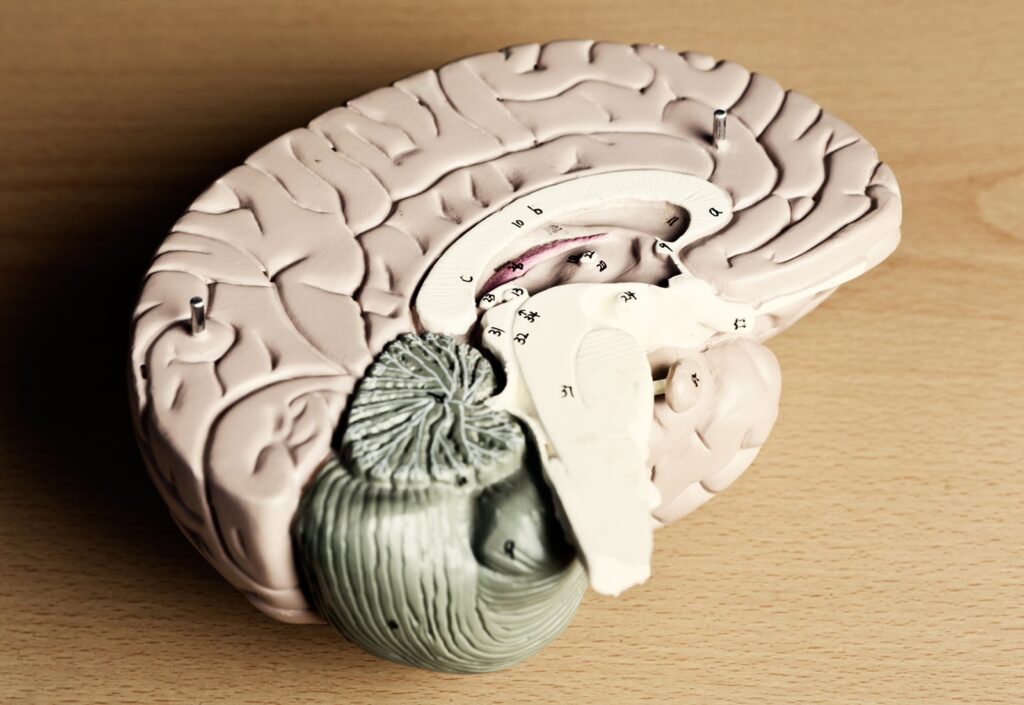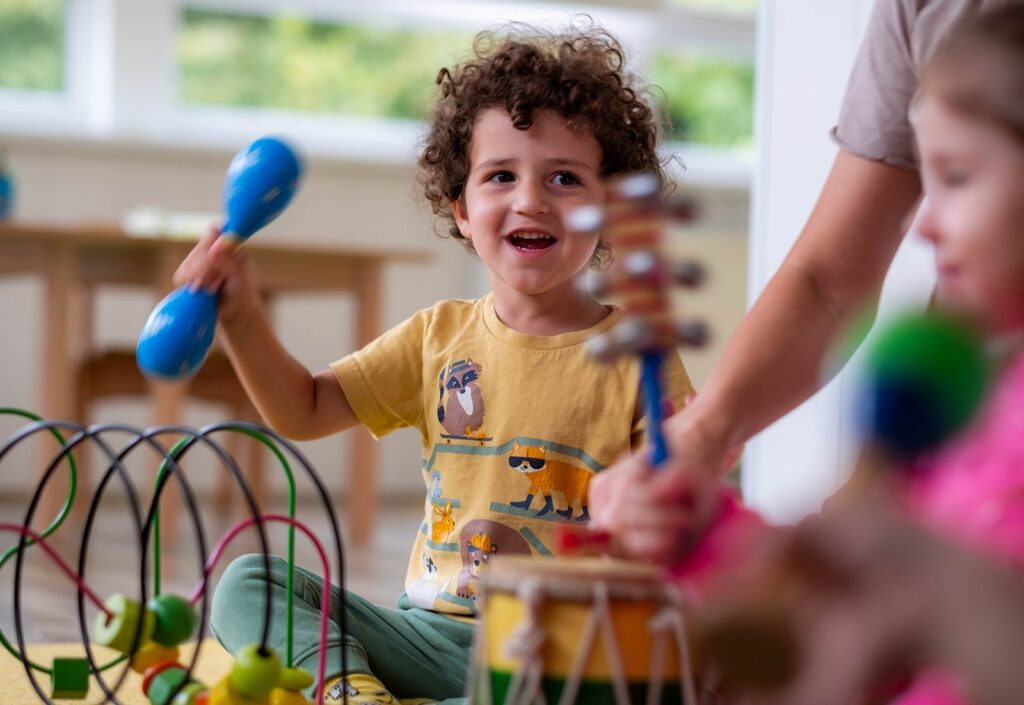A Foundation Laid in Silence
The brain begins to function before a child learns how to talk or read words and write numbers. It listens, it watches, it balances. The earliest foundation of learning emerges from our senses which operate separately while being deeply connected. This is multisensory processing: Sight, sound, touch, and movement work together in silent coordination to function automatically before conscious thought develops.
During an infant’s initial months of life they develop a fluent ability to process sensory information. A glance stabilizes balance. A sound turns the head. Contact with the hand creates awareness of someone’s presence beyond recognizing its texture. Learning starts as natural instinct which involves multiple senses before becoming effortful.
When Input Becomes Effort
The world loses its wholeness when this system stops functioning properly. Students who have difficulty sitting still or reading aloud in class show learning challenges because their brain needs to work harder to replace skills it didn’t fully develop automatically.
Adults may face similar disruptions. After sustaining a concussion individuals often experience pain when exposed to light. Motion feels disorienting. Driving demands deliberate attention when it used to be automatic. Friction now stands where ease once operated. The disruption of multisensory processing remains hidden from view yet creates significant impact.
The Unseen Architecture of Learning
The essential process at hand operates beyond academia because it functions through architectural principles. It underlies attention, memory, language, emotion. Both educational systems and therapeutic approaches from the top remain largely unaware of this fundamental process. Layering strategies on compromised integration building blocks becomes ineffective and frustrating.
Learning fundamentally begins with multisensory processing rather than serving as a mere support for learning. Partial restoration of the system reopens its inherent neural pathways to promote growth.
Restoring the Original Language
The therapeutic methods MST and OMST focus on restoration rather than teaching new material. They reintroduce rhythm. Passive subcortical stimulation methods like light and motion activate the same neural pathways that facilitated initial brain development.
This is not regression. It is restoration. During the measured quiet of restoration a change starts to happen. Balance returns. Focus lengthens. The effort lifts.
Learning becomes possible once more in that lift because it restores the original effortless state which did not require effort.
What Is Multisensory Processing?
A Convergence of Senses
Multisensory processing extends beyond simultaneous visual and auditory experiences. The brain processes multiple sensory inputs by merging them together to create a single unified experience. Multisensory processing enables children to simultaneously catch a ball and navigate a crowded hallway while understanding spoken language and watching written text.
The brainstem and midbrain which control automatic regulation and reflexive coordination serve as the starting point for sensory convergence. Through the thalamus which serves as the brain’s relay hub sensory signals reach their destination before spreading to higher cortical areas. Integration emerges through multiple layers that increase in complexity over time.
A healthy network enables the brain to perform fluently within its environment. Minor disruptions in neural processes can lead individuals to experience difficulties with orientation as well as timing, attention, and interpretation.
The Circuitry of Integration
The superior colliculus which resides deep within the midbrain structure serves as the central mechanism for merging visual, auditory, and somatosensory information. Neurons here are specialized for detecting cross-modal events: The superior colliculus detects multisensory events such as simultaneous visual flashes with auditory bangs and tactile movements with physical touches. The most reliable activation of these multisensory neurons occurs when the brain receives simultaneous input from several senses which strengthens the meaning of an event.
Biological redundancy serves vital evolutionary functions. The system provides quick detection capabilities along with fast responses and efficient movement through the environment. The system establishes foundational learning capabilities by enabling the cortex to work with processed information instead of raw input.
The ability of the brain to process information efficiently enables reading, listening, movement, and social interaction to occur seamlessly without needing conscious computation.
Automaticity vs. Compensation
People with complete multisensory pathways process integrations automatically. They require no deliberate thought. Whenever the system remains underdeveloped or experiences injury-induced disruption compensation mechanisms initiate. The brain may develop excessive dependence on a single sensory input channel. Children can find eye contact overwhelming which leads them to avoid it. Students who depend on rote memorization often exhibit this behavior due to their weak auditory processing abilities.
These behaviors should not be mistaken for laziness or inattention. These are indications that the system has to make do with improvised solutions because it lacks coherent functioning.
Beyond the Senses
People frequently misinterpret multisensory processing as just sensory. The influence of multisensory processing covers multiple domains including balance along with emotional responses and cognitive functions. This system determines our spatial movement patterns while also managing our energy levels and social responses alongside our ability to concentrate.
When the system breaks down it can cause symptoms such as restlessness alongside anxiety and difficulties with reading and memory and lead to chronic fatigue. The restoration of multisensory fluency leads to comprehensive enhancements spanning perception abilities along with functional performance and emotional wellbeing.
The unseen framework that supports most of our learning process remains hidden from view. This system works alongside cognition to ready the mind for complete engagement.
Multisensory Processing in Development
The Early Learning System
Before children understand language or numbers they experience the world through sensory perception. Multisensory processing functions as the foundational framework for all subsequent learning abilities. Through sensory experiences during infancy the brain develops its architecture which forms neural connections between visual, auditory, vestibular, and tactile systems to create a unified network.
From the time of conception this development starts and proceeds quickly through the first three years after birth. While balancing their head children learn to follow motion with their eyes and to reach toward sounds and respond to caregiver voices by orienting toward faces. These are not isolated feats. Integrated achievements emerge from the brain’s enhanced ability to merge diverse information sources into a unified response.
This system should function automatically when the child turns three years old. At this developmental stage children demonstrate readiness to access complex mental activities through speech and symbolic reasoning as well as peer interaction. If children lack this developmental groundwork they will experience delayed milestones which appear fragmented and require significant effort to accomplish.
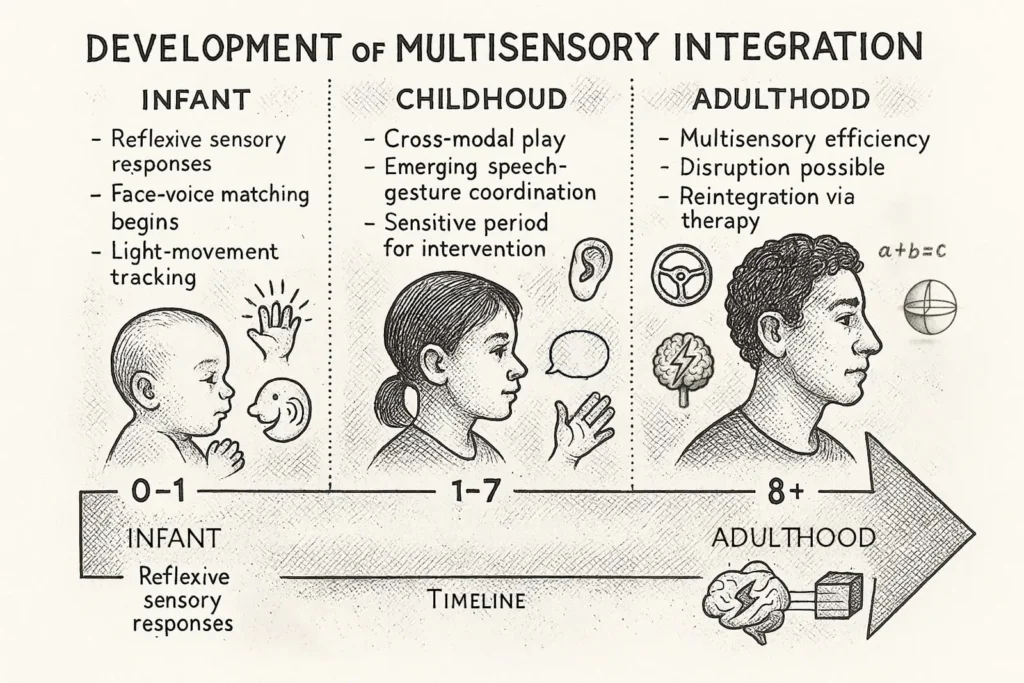
Delays in Integration
A child faces greater challenges in navigating their environment when multisensory integration experiences delays. Basic activities like copying from the board or following spoken instructions become much more challenging than they should be.
Such delays are not rare. Children diagnosed with autism spectrum disorders, ADHD, sensory processing disorder and other developmental profiles frequently experience these delays. These children are often labeled inattentive or oppositional, but the truth is simpler and more human: Their nervous systems struggle to interpret a world which operates with excessive loudness and speed alongside fragmented sensory experiences.
The roots of behavioral or cognitive difficulties often lie in the child’s lack of mastery over automatic sensory input coordination.
What’s Missed, and What’s Possible
Top-down learning approaches such as speech therapy and classroom instruction may encounter difficulties if multisensory processing does not develop according to its normal timetable. These interventions operate on the assumption of readiness that the individual does not currently have. They require focus, retention, comprehension. Without sensory fluency children cannot handle cognitive demands because their processing capacity becomes too limited.
Multisensory therapy represents a foundational restart that focuses on structural development rather than knowledge acquisition. It provides the nervous system with the types of input it expects in early development: Moving light and pulsating sound together with orienting motion provide essential developmental inputs. This therapy activates both physical and mental processes together while avoiding resistance from cognitive functions.
The Opportunity for Relearning
The aging process does not remove the brain’s capacity for multisensory plasticity. The initial three years represent the best period but remain the sole period for development. Through multisensory therapy anyone can reengage and rebuild their system followed by refinement at any point in their life. Multisensory therapy offers children who failed to integrate sensory input during early development and adults whose sensory systems were disrupted afterwards an opportunity to regain essential skills.
Not a shortcut, but a reboot. Multisensory therapy functions as an entry point toward cognitive development instead of replacing it.
Bottom-Up and Top-Down: A Hierarchy of Learning
The Bottom-Up Approach Explained
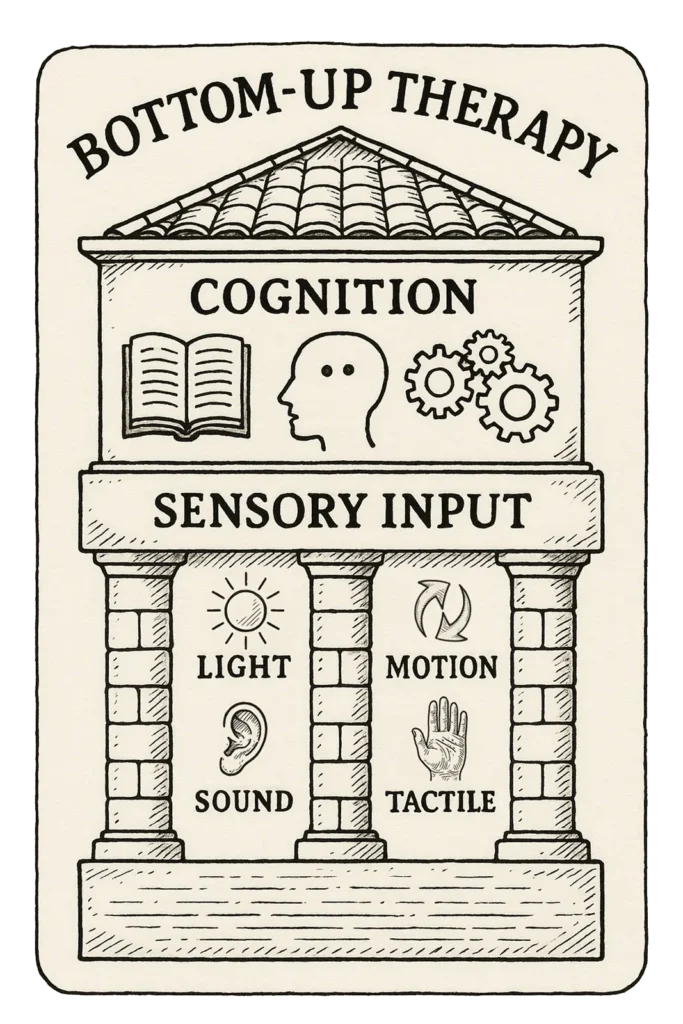
Traditional therapeutic approaches and educational frameworks typically start at the highest cognitive level. Change initiation requires the use of language techniques combined with reasoning approaches and behavioral teaching methods. When the brain’s lower systems responsible for sensation and automatic regulation fail to function properly top-down approaches become ineffective.
The bottom-up therapy approach begins its process at the foundational level of nervous system function which takes input as its starting point.
MST and OMST bottom-up therapy works through passive subcortical stimulation from light, motion, sound, and tactile cues. The timing and patterns of these inputs match the environmental stimuli that the developing brain anticipates. The application of colored light activates both retinal pathways and autonomic centers. Vestibular stimulation activates balance and proprioception. Auditory tracks encourage regulation and spatial orientation.
The process presented here operates differently from conventional training methods. No instructions require your attention while you complete no specific tasks. The nervous system receives time to adjust itself and regain its natural rhythm as well as recover memory.
Why Top-Down Sometimes Fails
People undergoing top-down therapy can experience confusion or exhaustion if their sensory foundation remains unstable. A child with multisensory processing issues may hear instructions yet fail to understand their significance. Individuals recovering from brain injury who start cognitive therapy sessions often face interruptions from light sensitivity or nausea symptoms. The challenges faced are not due to motivational deficits but to the disparity between the required demands and individual readiness.
Developing executive function skills on top of unstable sensory processing resembles constructing a second floor on an unsteady foundation. It can be done—but it won’t hold.
Multisensory therapy recognizes sensory imbalance and reverses the treatment sequence. Enhancing foundational stability enables structures to develop upward without restriction.
The Sequence of Engagement
In practice, MST begins with input alone. During the earliest sessions the person will remain motionless while their eyes stay open to observe colored light and their body receives gentle movement while sound filters into their ears. As the brain learns to anticipate incoming stimuli over time its system becomes more responsive.
From there, output begins to return. Eyes track more steadily. Attention lengthens. Initially difficult tasks evolve into manageable activities that eventually become easy. The effectiveness of top-down engagement emerges when bottom-up systems begin to provide adequate support.
The external change looks minimal but indicates significant internal brain restructuring. Stimulus no longer causes overload. The foundation is once again bearing weight.
Preparing the Brain to Learn
Cognition, behavior, speech, and memory operate through interconnected mechanisms rather than functioning independently. A continual and silent synchronization of sensory information forms the basis of their operation. Once the coordination of sensory input becomes disrupted the higher function of the brain declines. After restoration the brain achieves the ability to learn again by way of preparedness rather than force.
This is the promise of bottom-up therapy: The purpose here is to set the brain up so it can fully accept cognitive tasks. Learning should be a process that the brain accepts rather than fights against.
Multisensory Processing and Brain Injury Recovery
Multisensory Dysfunction Post-TBI
Head injuries typically affect multiple brain areas rather than just one specific part. The impact of a brain injury commonly starts with ripple effects that interfere with neural networks and impair automatic processes. Multisensory processing stands out as both extremely vulnerable and significantly disrupted.
Following a concussion or mild traumatic brain injury (mTBI), patients frequently report a cluster of seemingly unrelated symptoms: People who have experienced a concussion or mild traumatic brain injury often suffer from dizziness together with sensitivities to sound and light and experience brain fog which causes difficulty focusing while suffering motion sickness and emotional instability. What connects them is not their surface expression, but their source: The brain suffers from a malfunction in its ability to manage and combine sensory signals.
Standard scans may show nothing. Ordinary activities like driving or grocery shopping become challenging and sometimes impossible to endure. The environment remains the same. The difficulty arises from the brain’s impaired capacity to interpret sensory information.
The Invisible Injury
Multisensory dysfunction remains hidden to the eye unlike physical breaks in bones. MRI scans do not reveal any signs of multisensory dysfunction. The condition attacks a person’s independence and identity with the same intensity. Patients frequently report experiencing the world as “wrong,” “too loud,” “too fast,” or “unreal,” while their ability to focus suffers because their perception systems are overloaded.
The disparity between what people look like and their hidden internal battles makes diagnosis more difficult and treatment more complex while increasing emotional distress.
The good news: The brain can frequently retrieve known information when provided with proper conditions and suitable input.
The OMST Approach to Rehabilitation
Optometric Multisensory Therapy provides a recovery route by creating patterns instead of teaching. The clinical model over 30 days involves 12 days of Syntonic phototherapy with vestibular motion exercises and auditory modulation paired with light somatosensory stimulation. Following the initial treatment phase patients undergo 18 days of organized therapy at home.
The therapy’s purpose is to restore usual sensory coordination patterns rather than to provide cognitive training. The brain starts to identify signals again after being overwhelmed by static. Motion becomes tolerable. Lights dim. Thoughts clarify.
Research indicates measurable progress in visual evoked potential (VEP), kinetic color field perception and near-point convergence abilities. Patients report subjective enhancements in their sleep quality as well as mood and balance along with better reading capability and their life quality overall.
From Recalibration to Recovery
OMST results in a balanced system rather than the restoration of an isolated skill. The dizziness softens. The headaches relent. Patients experience relief as the mental haze that previously obscured their thoughts starts to dissipate.
Patients report that the experience of “feeling normal again” emerges not from added elements but from the restoration of essential functions.
Multisensory therapy functions as a supportive enhancement rather than a standalone cure in complex TBI rehabilitation. It amplifies them. The multisensory approach establishes the foundation needed for cognitive rehabilitation and speech therapy as well as emotional recovery.
The brain regains its sense of order through this process. The establishment of order generates capacity which leads to clarity and functional improvement while also bringing hope.
Reintegrating the Senses: Toward Learning Without Friction
From Input to Ease
Life becomes seamless when our senses function together smoothly. The eyes move across the room while the body maintains balance. The head turns when a voice calls out through instinct not conscious control. The seamless way humans interact with their environment comes from sensory systems which operate unnoticed and effortlessly in the background.
The absence of sensory integration leads to increased mental effort. The world becomes noisy, unpredictable, disjointed. Skills that used to operate automatically like reading signs and moving through crowds now require active thought. Fatigue sets in. Frustration grows. Navigating daily activities turns into a cognitive burden.
Multisensory therapy doesn’t push through that resistance. It listens to it. The process starts over by gradually restoring structure to areas that were previously chaotic.
The Experience of Reorganization
Patients frequently characterize their healing process as a gentle return to consciousness. Following multiple MST sessions individuals often find that they no longer react to the sound of fluorescent lights. Driving becomes easier. The previous dizziness patients experienced when they turned their head starts to diminish. They are not just improving—they are recalibrating.
The progress observed develops from giving patients space to adapt rather than direct instruction. After becoming overwhelmed the nervous system regains its ability to trust incoming sensory information. The brain regains its power to process the world without feeling threatened by its complexity.
Many people experience not just restored functions but also restored confidence which allows them to interact with their surroundings without any hesitation.
A Platform for All Learning
Higher brain functions require less compensatory effort when multisensory coherence returns to normal. Attention stabilizes. Emotional reactivity diminishes. The ability to utilize speech, memory and executive function improves because they were not damaged but rather hidden under chaotic conditions.
MST functions as a catalyst that enhances the effectiveness of other treatment methods. Children who monitor auditory and visual stimuli during therapy sessions achieve better speech therapy results. Cognitive therapy demands less effort from the brain when it doesn’t need to process multiple distractions. Physical coordination in sports becomes better when peripheral vision and body awareness regain proper alignment.
Multisensory processing represents the basic level of functioning rather than a supplementary ability. The entire system advances further when it reaches stability.
The Return of Simplicity
The true power of MST lies not in what it adds, but in what it restores: People can perform actions spontaneously without excessive thought processes while maintaining focus effortlessly and staying engaged without pulling back.
The restoration process enables many patients to discover benefits which extend beyond simple symptom relief. They find ease. Simplicity. Wholeness.
Not perfection, but peace.
A Return to Wholeness
Beyond Symptom Relief
Not all progress is loud. Some of the most profound changes occur silently when a child stays still for the first time without prompting, when a concussion patient reads without pain, and when a parent observes their child laughing more and arguing less.
These moments appear small yet hold profound significance. They demonstrate when the nervous system stops fighting environmental demands to work effectively. The brain has returned to its natural rhythm after recovering from being overloaded. The person experiences a return to their presence alongside recovery.
Healing fundamentally means restoring potential rather than removing challenges.
The Rhythm Beneath Cognition
Healthy multisensory integration allows cognition to operate naturally without active pushing forward. Learning shifts from compensation to connection. The process of emotional regulation transitions from suppression methods to natural equilibrium. The brain functions directly without having to find workarounds to its own processes.
Once the rhythm returns it produces a serene understanding. Tasks feel easier. Interactions feel smoother. Even rest feels more restorative. Symptoms diminish alongside the removal of internal friction.
This is not magic. It is biology. Within the proper environment and with adequate resources the system functions exactly as it was designed.
Learning, Rediscovered
In the rush to remediate, we often forget the most essential truth about learning: it is supposed to be intuitive. It is supposed to feel natural. Multisensory integration disruption leads to the loss of intuitive understanding.
MST does not bypass this challenge. It meets it at the source. Restoring the brain’s initial pathways enables higher learning to develop organically from its foundational stages upward while providing foundational support at every stage.
Students who experienced difficulties in engagement start to show initiative. Adults who previously dreaded light, noise, and motion now accept their presence back into their lives. What was once effortful becomes familiar again.
Wholeness Reimagined
Multisensory therapy is not about chasing normal. The therapy aims to reunite our internal systems that expended excessive energy to maintain alignment. The process of integration extends beyond neurological functions because it encompasses human experience.
The process of reconnection through sensory experiences like light or sound as well as motion or touch restores not only basic functionality but also brings about a more profound and gentle experience.
A sense of wholeness.
